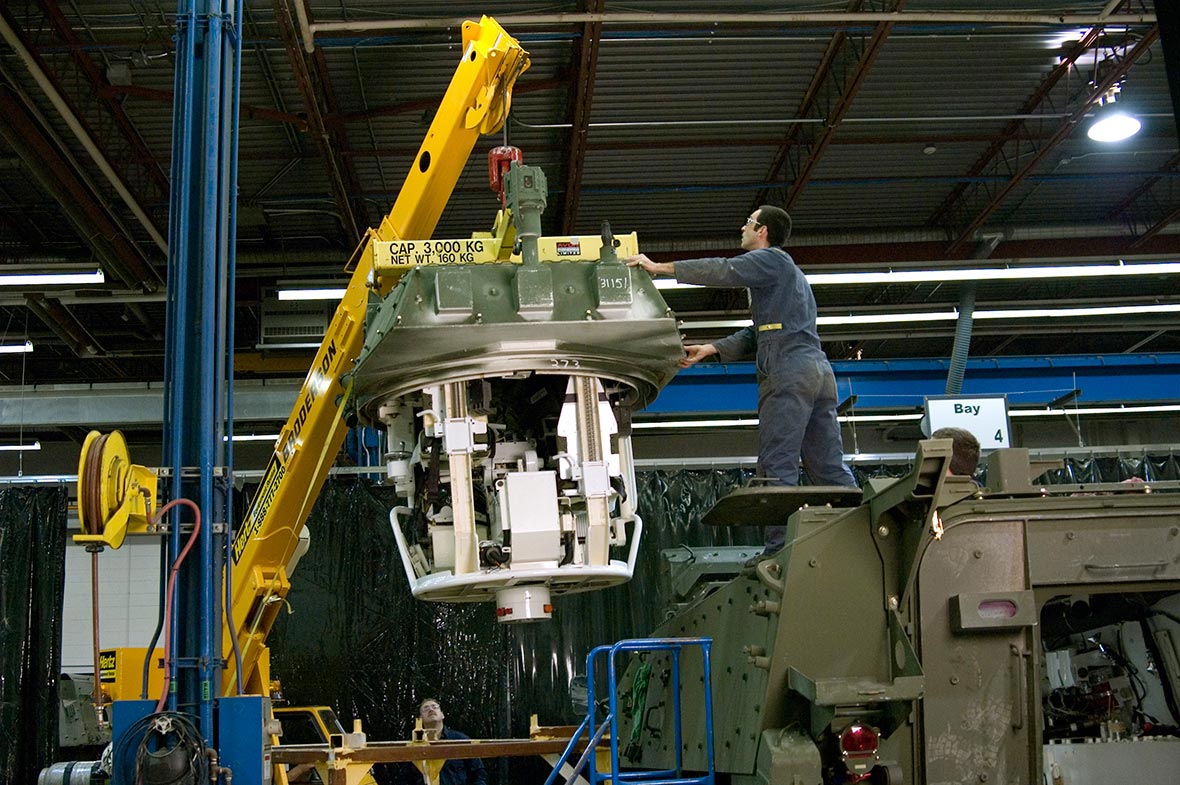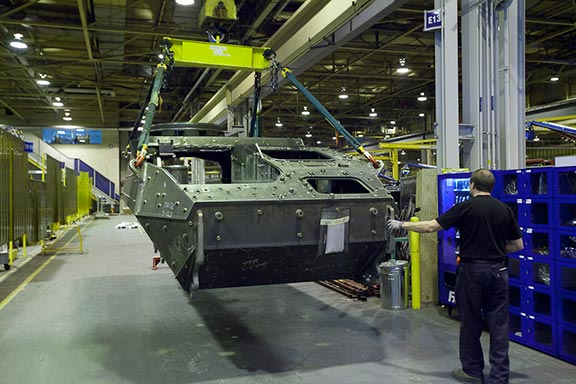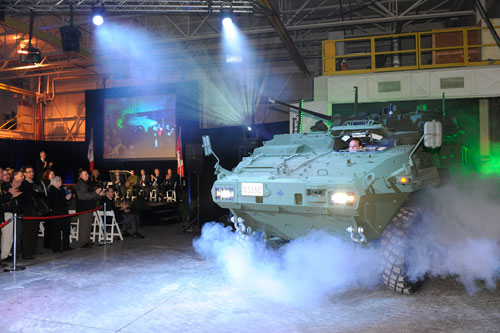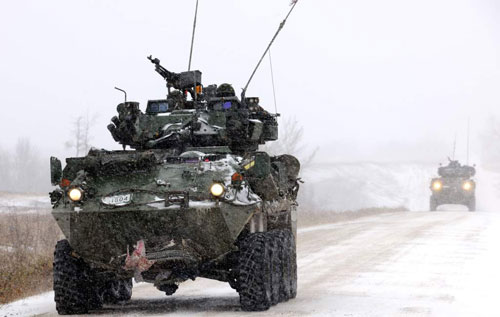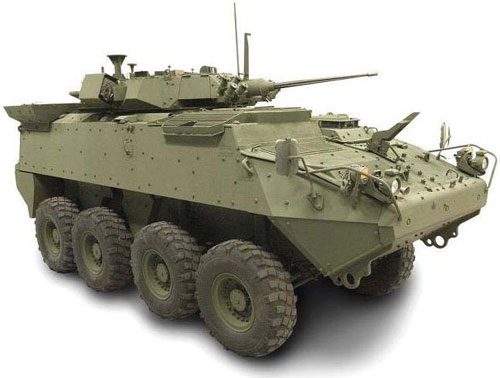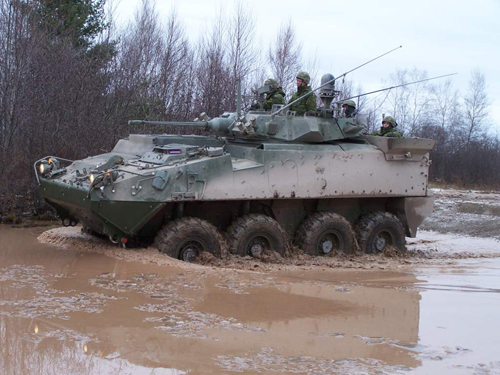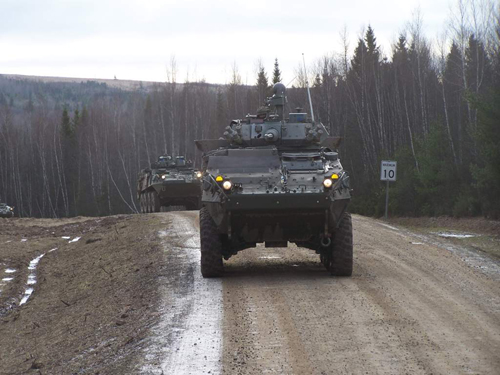Light armoured vehicle III upgrade (LAVUP)
Project summary
The LAV III fleet will receive turret and chassis (hull) upgrades, which will improve the protection, mobility, and lethality of the LAV III platform, while maximizing command support and improving crew ergonomics. The project will capitalize on existing and evolving technology to modernize a portion of the existing LAV III fleet to ensure it remains the backbone of domestic and expeditionary task forces. It will also extend the life span of the LAV to 2035.
This project provides the Canadian Army with a flexible, multi-purpose capability to respond effectively and successfully to the full spectrum of military operations.
The first on-schedule delivery of upgraded LAVs was announced in January 2013. Final vehicle delivery occurred in July 2019.
Project phases
Currently in Phase 4: Implementation
1. Identification
1. Identification
- October 2008
2. Options analysis
2. Options analysis
- Not applicable
3. Definition
3. Definition
- Preliminary project approval: June 18, 2009
4. Implementation
4. Implementation
- Project approval: October 2011
- Contract award: October 2011
- First delivery: December 19, 2012
- Initial operational capability: June 6, 2014
- Approval of amended implementation: November 24, 2016
- Full operational capability: Spring 2020
5. Close-out
5. Close-out
- Spring 2021
Learn more about the Defence procurement process
Additional information
Project updates
Project updates
September 2019
General Dynamics Land Systems – Canada delivers the final vehicle in July 2019.
March 20, 2019
537 of 550 upgraded vehicles have been delivered, including 128 of 141 LORIT.
January 2019
Canada agreed to an accelerated delivery schedule with the contractor that will complete all vehicle deliveries by April 2019 (previously July 2019).
May 4, 2018
470 of 550 upgraded vehicles have been delivered.
February 2017
The Government of Canada announced a $404 million (tax included) contract amendment with General Dynamics Land Systems – Canada (GDLS–C) of London, Ontario, to provide chassis upgrades to 141 LAV Operational Requirement Integration Task (LORIT) vehicles. These vehicles were originally scheduled to receive turret upgrades only.
December 2016
A total of 409 (out of 550) vehicles have been upgraded.
August 2016
380 vehicles are delivered to Canada. The Canadian Army conducted operator and driver training across the various units located in Gagetown, Valcartier, Petawawa, Edmonton, and Shilo. The upgraded LAV is ready for operational deployments.
July 2016
The Commander of the Canadian Army accepted the upgraded LAV III as the Canadian Army deployable LAV fleet.
May 2016
More than 110 upgraded LAV III were successfully tested during exercise MAPLE RESOLVE 16 in Wainwright.
January 24, 2013
The first upgraded LAV III are delivered in London, Ontario.
November 2012
The contract is amended to exercise the option to upgrade 66 additional LAV III for an additional $151 million, in support of the Light Armoured Vehicle Reconnaissance Surveillance System Upgrade project.
October 2011
A sole-source contract for upgrade of 550 vehicles, for $1.064 billion, is awarded to General Dynamics Land Systems ‐ Canada (London, Ontario).
July 2009
The LAV III UP Project is announced.
Benefiting Canadian industry
Benefiting Canadian industry
Direct engagement is done with General Dynamics Land Systems - Canada, the original equipment manufacturer of the Light Armoured Vehicle III and owner of the intellectual property.
The Industrial and Regional Benefits Policy was applied to the LAV UP Implementation Contract. The total IRB obligations are $1,604M and they have been fully completed.
Contractors
Some of the links below lead to websites that are not part of the Government of Canada and are available in English only
Technical information
About the Light Armoured Vehicle III Upgrade (LAVUP)
Variants
- Infantry section carrier (ISC) vehicles
- Command post (CP) vehicles
- Engineer vehicles
- Reconnaissance (Recce) vehicles
- Observation post (OP) vehicles
Engine:
- Water-cooled 6 cylinder 450 horsepower turbo-charged diesel engine.
- 7 speed automatic transmission.
Specifications (ISC only)
Weight
- Basic weight: 20,638 kg (45,500 lbs)
- Combat load (with Add-on-Armour): 28,576 kg (63,000 lbs)
Dimensions
- Length: 7,827 mm
- Width: 3,250 mm
- Height: 3,266 mm
Mobility
- Highway speed: 100 km/h
- Off-road speed: 40 km/h
- Highway range: 600 km
- Off road range: 450 km
- Maximum grade: 60%
- Side slope: 30%
- Ditch cross: 2 m
Fuel
- Type: Diesel or JP-8
- Capacity: 207L
- Consumption: 0.80 L/km
Capabilities:
- Arctic: No
- Add-on armour: Yes
Crew:
- Crew: 3
- Passengers: 7
Weapons
- M242 25-mm Bushmaster cannon
- C6 7.62-mm coaxial, medium machine gun
- C9A2 5.56-mm light machine gun
- 76-mm multibarrel smoke grenade discharger
Estimated life expectancy:
- 20 years
Project costs
Project costs
The project cost is approximately $1.75 billion. This includes acquisition, project management, infrastructure, contracts and contingency costs to upgrade 550 vehicles.
Issues/Risk
Issues/Risk
Schedule
Although vehicle deliveries are complete, the delivered vehicles still have technical issues that need to be fixed through a retrofit program in a timely and synchronized manner to support managed-readiness training cycle.
Technical
The project is still addressing a number of technical issues identified through the fielding and increased use of the vehicles. All the technical issues are tracking toward resolution, along with their eventual fleet implementation.
